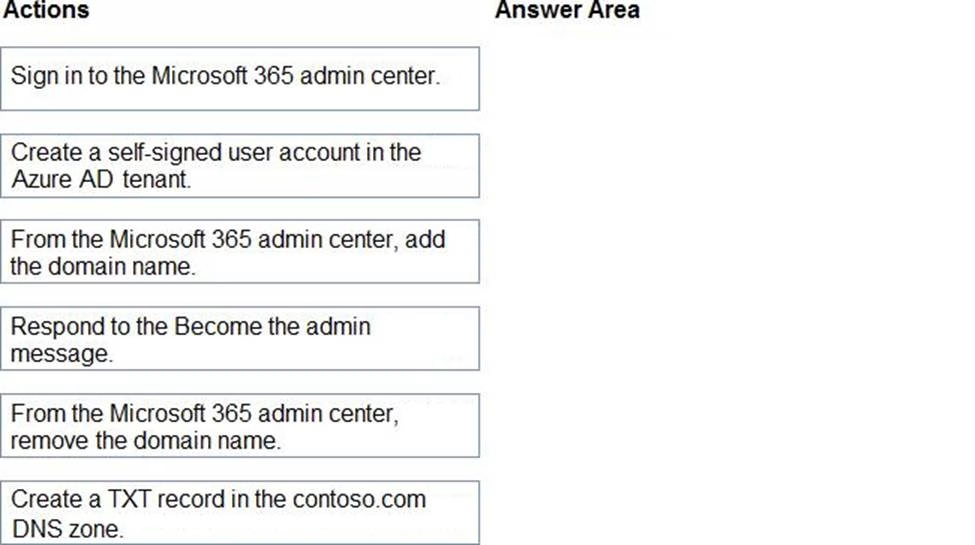Microsoft SC-300 Microsoft Identity and Access Administrator Online Training
Microsoft SC-300 Online Training
The questions for SC-300 were last updated at Dec 27,2025.
- Exam Code: SC-300
- Exam Name: Microsoft Identity and Access Administrator
- Certification Provider: Microsoft
- Latest update: Dec 27,2025
You have a Microsoft 365 tenant.
All users must use the Microsoft Authenticator app for multi-factor authentication (MFA) when accessing Microsoft 365 services.
Some users report that they received an MFA prompt on their Microsoft Authenticator app without initiating a sign-in request.
You need to block the users automatically when they report an MFA request that they did not Initiate.
Solution: From the Azure portal, you configure the Block/unblock users settings for multi-factor authentication (MFA).
Does this meet the goal?
- A . Yes
- B . No
You have a Microsoft 365 tenant.
All users must use the Microsoft Authenticator app for multi-factor authentication (MFA) when accessing Microsoft 365 services.
Some users report that they received an MFA prompt on their Microsoft Authenticator app without initiating a sign-in request.
You need to block the users automatically when they report an MFA request that they did not Initiate.
Solution: From the Azure portal, you configure the Account lockout settings for multi-factor authentication (MFA).
Does this meet the goal?
- A . Yes
- B . No
You have a Microsoft 365 tenant.
All users must use the Microsoft Authenticator app for multi-factor authentication (MFA) when accessing Microsoft 365 services.
Some users report that they received an MFA prompt on their Microsoft Authenticator app without initiating a sign-in request.
You need to block the users automatically when they report an MFA request that they did not Initiate.
Solution: From the Azure portal, you configure the Fraud alert settings for multi-factor authentication (MFA).
Does this meet the goal?
- A . Yes
- B . No
You have an Azure Active Directory (Azure AD) tenant that contains the following objects:
✑ A device named Device1
✑ Users named User1, User2, User3, User4, and User5
✑ Groups named Group1, Group2, Group3, Group4, and Group5
The groups are configured as shown in the following table.

To which groups can you assign a Microsoft Office 365 Enterprise E5 license directly?
- A . Group1 and Group4 only
- B . Group1, Group2, Group3, Group4, and Group5
- C . Group1 and Group2 only
- D . Group1 only
- E . Group1, Group2, Group4, and Group5 only
You have a Microsoft 365 tenant that uses the domain named fabrikam.com.
The Guest invite settings for Azure Active Directory (Azure AD) are configured as shown in the exhibit. (Click the Exhibit tab.)

A user named [email protected] shares a Microsoft SharePoint Online document library to the users shown in the following table.

Which users will be emailed a passcode?
- A . User2 only
- B . User1 only
- C . User1 and User2 only
- D . User1, User2, and User3
You have 2,500 users who are assigned Microsoft Office 365 Enterprise E3 licenses. The licenses are assigned to individual users.
From the Groups blade in the Azure Active Directory admin center, you assign Microsoft 365 Enterprise E5 licenses to the users.
You need to remove the Office 365 Enterprise E3 licenses from the users by using the least amount of administrative effort.
What should you use?
- A . the Identity Governance blade in the Azure Active Directory admin center
- B . the Set-AzureAdUser cmdlet
- C . the Licenses blade in the Azure Active Directory admin center
- D . the Set-WindowsProductKey cmdlet
HOTSPOT
You have a Microsoft 365 tenant named contoso.com.
Guest user access is enabled.
Users are invited to collaborate with contoso.com as shown in the following table.

From the External collaboration settings in the Azure Active Directory admin center, you configure the Collaboration restrictions settings as shown in the following exhibit.

From a Microsoft SharePoint Online site, a user invites [email protected] to the site.
For each of the following statements, select Yes if the statement is true. Otherwise, select No. NOTE: Each correct selection is worth one point.

You have an Azure Active Directory (Azure AD) tenant named contoso.com.
You plan to bulk invite Azure AD business-to-business (B2B) collaboration users.
Which two parameters must you include when you create the bulk invite? Each correct answer presents part of the solutio.n. NOTE: Each correct selection is worth one point.
- A . email address
- B . redirection URL
- C . username
- D . shared key
- E . password
You have an Azure Active Directory (Azure AD) tenant that contains the objects shown in the following table.

Which objects can you add as members to Group3?
- A . User2 and Group2 only
- B . User2, Group1, and Group2 only
- C . User1, User2, Group1 and Group2
- D . User1 and User2 only
- E . User2 only
DRAG DROP
You have an on-premises Microsoft Exchange organization that uses an SMTP address space of contoso.com.
You discover that users use their email address for self-service sign-up to Microsoft 365 services.
You need to gain global administrator privileges to the Azure Active Directory (Azure AD) tenant that contains the self-signed users.
Which four actions should you perform in sequence? To answer, move the appropriate actions from the list of actions to the answer area and arrange them in the correct order.

Latest SC-300 Dumps Valid Version with 106 Q&As
Latest And Valid Q&A | Instant Download | Once Fail, Full Refund



